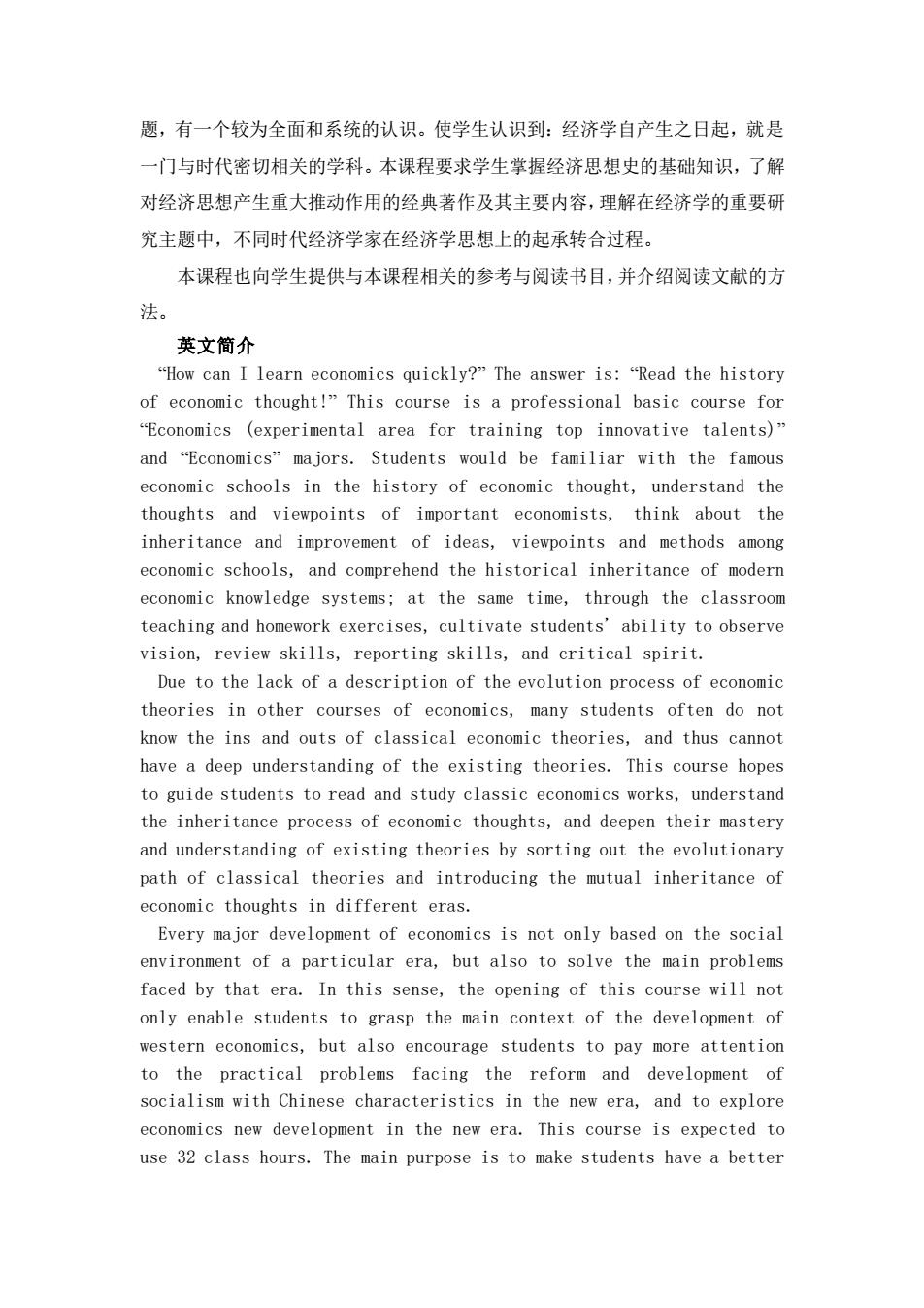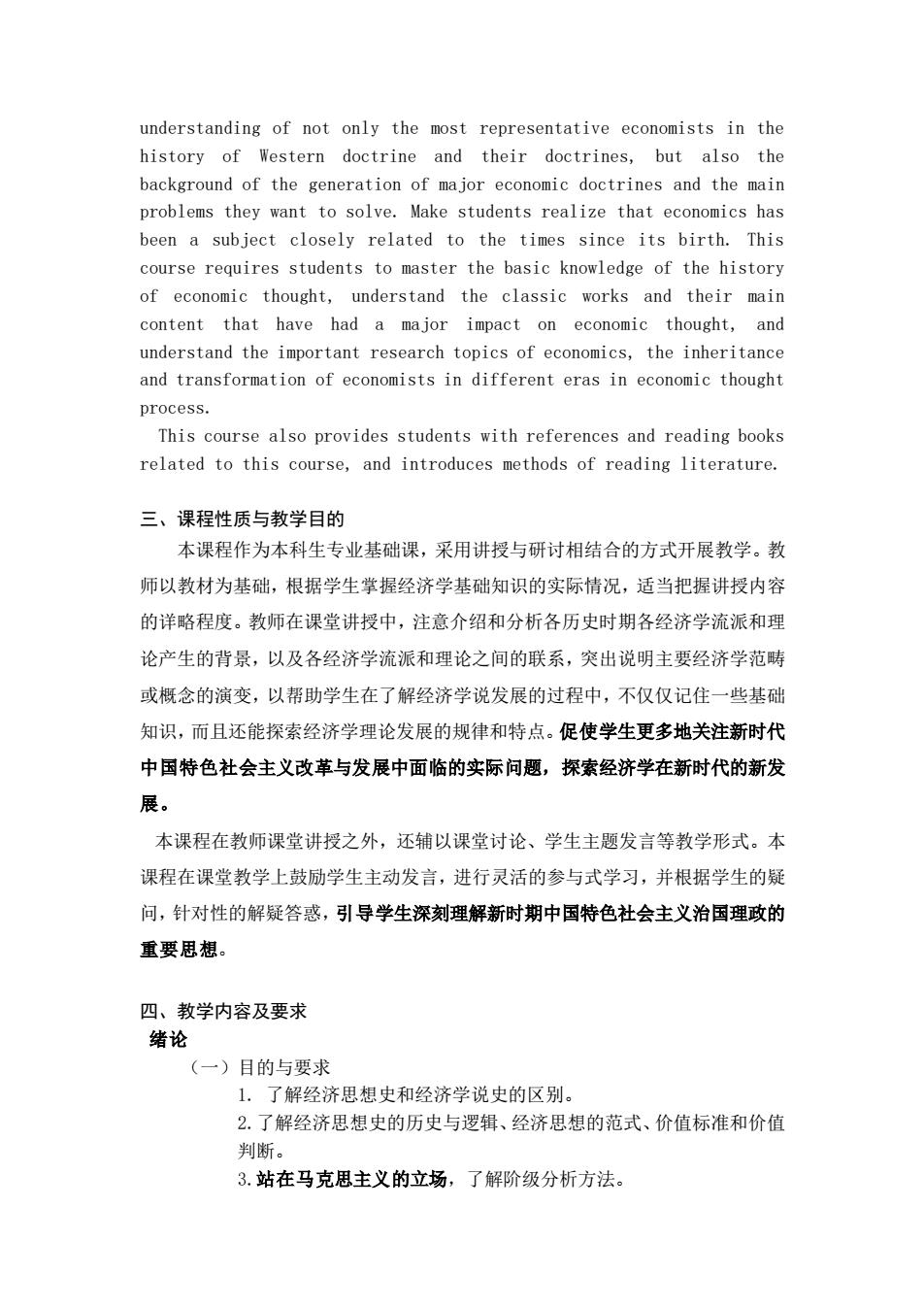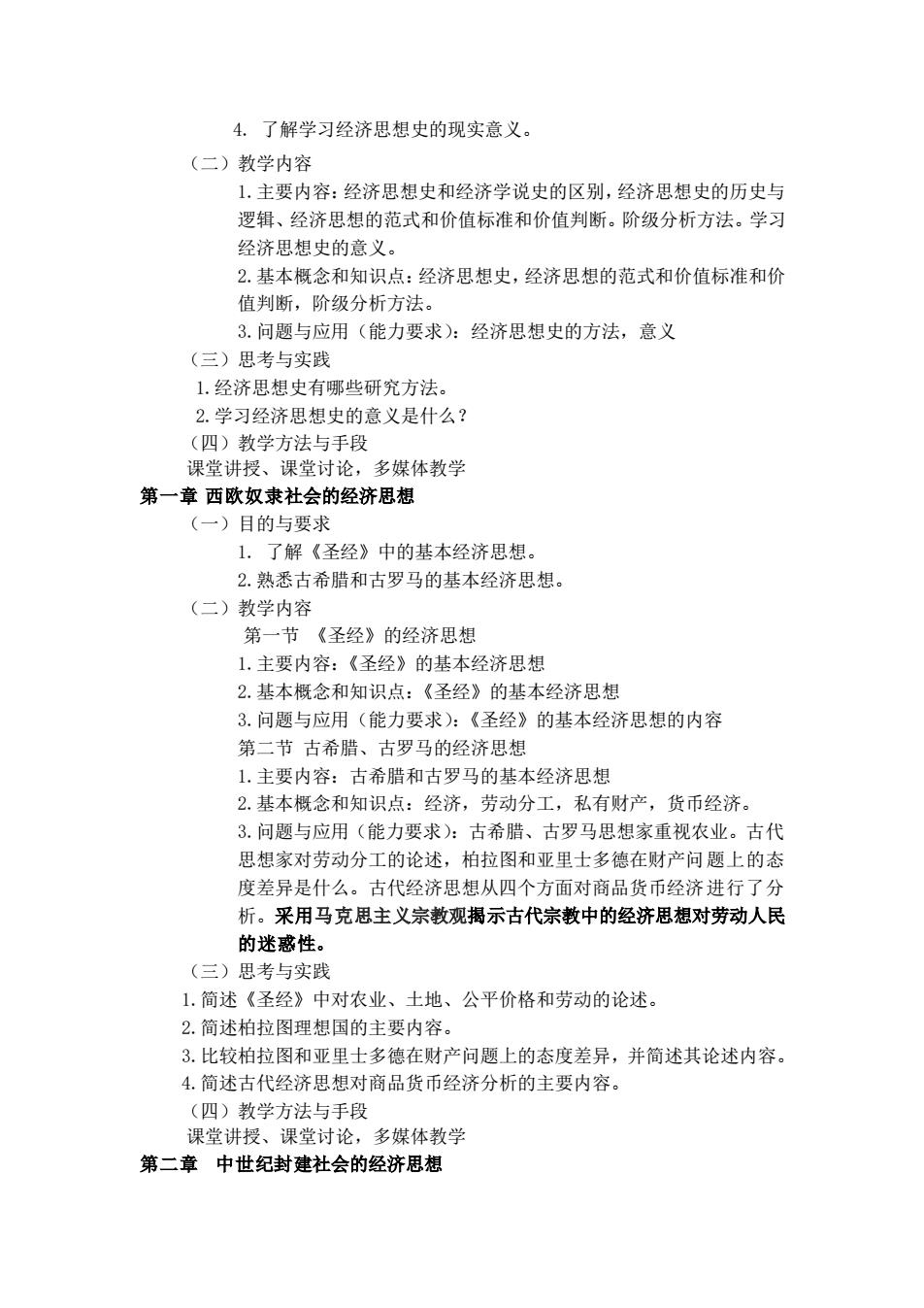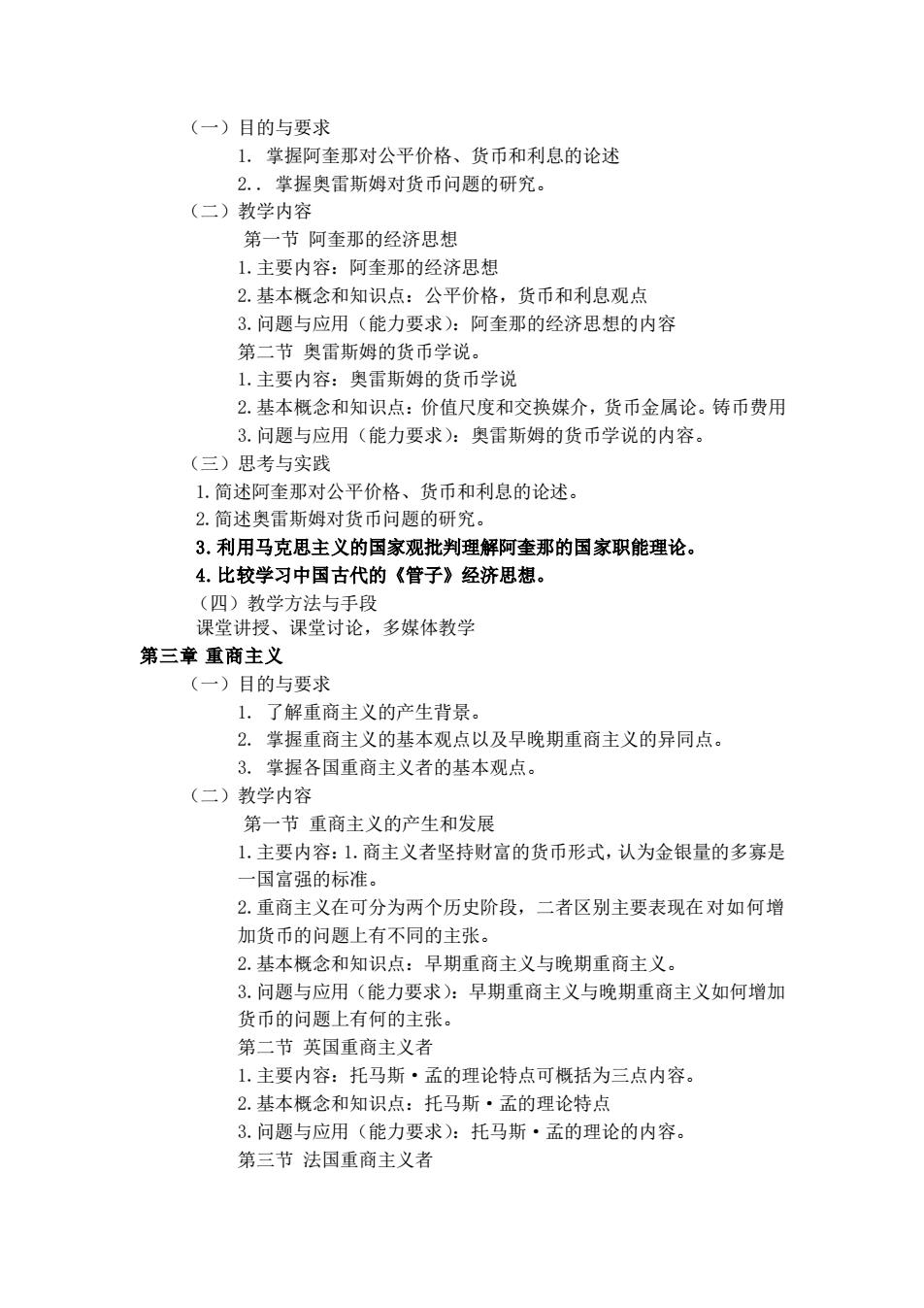
《经济思想史》课程教学大纲 一、课程基本信息 课程代码:16117502 课程名称:经济思想史 英文名称:History of Economic Thought 课程类别:专业课 学时:32 学分:2 适用对象:经济学(拔尖创新人才培养实验区)、经济学 考核方式:考试 先修课程:微观经济学、宏观经济学、微积分 二、课程简介 中文简介 “如何能快速学好经济学?”答案是:“好好读读经济思想史!”本课程是“经 济学(拔尖创新人才培养实验区)”、“经济学”专业学生的专业基础课,旨在让 学生熟悉经济思想史上著名的经济学流派,理解重要经济学家的思想观点,思考 经济学流派之间思想、观点和方法的传承与改进,领悟现代经济学知识体系的历 史传承:同时,通过课堂教学和课外作业练习,培养学生观察视野、综述能力、 转述技巧和批判精神等方面的能力。 经济学其他课程由于缺乏经济学理论演化过程的刻画,许多学生往往不知道 经典经济学理论的来龙去脉,从而无法对现有理论作出深刻理解。本课程希望通 过梳理经典理论演化路径以及介绍不同时代经济学思想之间的相互传承,引导学 生阅读和学习经典的经济学著作,了解经济思想的传承过程,从而加深对现有理 论的掌握和理解。 经济学的每一次重大发展,都不仅出于某一特定时代的社会环境,而且也是 为了解决该时代所面临的主要问题。从这个意义上来说,开设这门课程,不仅使 学生能掌握西方经济学发展的主要脉络,而且将促使学生更多地关注新时代中国 特色社会主义改革与发展中面临的实际问题,探索经济学在新时代的新发展。本 课程预计用32课时,主要目的是使学生不仅对西方学说史上最具有代表性的经 济学家及其学说本身,而且对各主要经济学说产生的时代背景和主要想解决的问
《经济思想史》课程教学大纲 一、课程基本信息 课程代码:16117502 课程名称:经济思想史 英文名称:History of Economic Thought 课程类别:专业课 学时:32 学分:2 适用对象: 经济学(拔尖创新人才培养实验区)、经济学 考核方式:考试 先修课程:微观经济学、宏观经济学、微积分 二、课程简介 中文简介 “如何能快速学好经济学?”答案是:“好好读读经济思想史!”本课程是“经 济学(拔尖创新人才培养实验区) ”、“经济学”专业学生的专业基础课,旨在让 学生熟悉经济思想史上著名的经济学流派,理解重要经济学家的思想观点,思考 经济学流派之间思想、观点和方法的传承与改进,领悟现代经济学知识体系的历 史传承;同时,通过课堂教学和课外作业练习,培养学生观察视野、综述能力、 转述技巧和批判精神等方面的能力。 经济学其他课程由于缺乏经济学理论演化过程的刻画,许多学生往往不知道 经典经济学理论的来龙去脉,从而无法对现有理论作出深刻理解。本课程希望通 过梳理经典理论演化路径以及介绍不同时代经济学思想之间的相互传承,引导学 生阅读和学习经典的经济学著作,了解经济思想的传承过程,从而加深对现有理 论的掌握和理解。 经济学的每一次重大发展,都不仅出于某一特定时代的社会环境,而且也是 为了解决该时代所面临的主要问题。从这个意义上来说,开设这门课程,不仅使 学生能掌握西方经济学发展的主要脉络,而且将促使学生更多地关注新时代中国 特色社会主义改革与发展中面临的实际问题,探索经济学在新时代的新发展。本 课程预计用 32 课时,主要目的是使学生不仅对西方学说史上最具有代表性的经 济学家及其学说本身,而且对各主要经济学说产生的时代背景和主要想解决的问

题,有一个较为全面和系统的认识。使学生认识到:经济学自产生之日起,就是 一门与时代密切相关的学科。本课程要求学生掌握经济思想史的基础知识,了解 对经济思想产生重大推动作用的经典著作及其主要内容,理解在经济学的重要研 究主题中,不同时代经济学家在经济学思想上的起承转合过程。 本课程也向学生提供与本课程相关的参考与阅读书目,并介绍阅读文献的方 法。 英文简介 "How can I learn economics quickly?"The answer is:"Read the history of economic thought!"This course is a professional basic course for "Economics (experimental area for training top innovative talents)" and "Economics"majors.Students would be familiar with the famous economic schools in the history of economic thought,understand the thoughts and viewpoints of important economists,think about the inheritance and improvement of ideas,viewpoints and methods among economic schools,and comprehend the historical inheritance of modern economic knowledge systems;at the same time,through the classroom teaching and homework exercises,cultivate students'ability to observe vision,review skills,reporting skills,and critical spirit. Due to the lack of a description of the evolution process of economic theories in other courses of economics,many students often do not know the ins and outs of classical economic theories,and thus cannot have a deep understanding of the existing theories.This course hopes to guide students to read and study classic economics works,understand the inheritance process of economic thoughts,and deepen their mastery and understanding of existing theories by sorting out the evolutionary path of classical theories and introducing the mutual inheritance of economic thoughts in different eras. Every major development of economics is not only based on the social environment of a particular era,but also to solve the main problems faced by that era.In this sense,the opening of this course will not only enable students to grasp the main context of the development of western economics,but also encourage students to pay more attention to the practical problems facing the reform and development of socialism with Chinese characteristics in the new era,and to explore economics new development in the new era.This course is expected to use 32 class hours.The main purpose is to make students have a better
题,有一个较为全面和系统的认识。使学生认识到:经济学自产生之日起,就是 一门与时代密切相关的学科。本课程要求学生掌握经济思想史的基础知识,了解 对经济思想产生重大推动作用的经典著作及其主要内容,理解在经济学的重要研 究主题中,不同时代经济学家在经济学思想上的起承转合过程。 本课程也向学生提供与本课程相关的参考与阅读书目,并介绍阅读文献的方 法。 英文简介 “How can I learn economics quickly?” The answer is: “Read the history of economic thought!” This course is a professional basic course for “Economics (experimental area for training top innovative talents)” and “Economics” majors. Students would be familiar with the famous economic schools in the history of economic thought, understand the thoughts and viewpoints of important economists, think about the inheritance and improvement of ideas, viewpoints and methods among economic schools, and comprehend the historical inheritance of modern economic knowledge systems; at the same time, through the classroom teaching and homework exercises, cultivate students' ability to observe vision, review skills, reporting skills, and critical spirit. Due to the lack of a description of the evolution process of economic theories in other courses of economics, many students often do not know the ins and outs of classical economic theories, and thus cannot have a deep understanding of the existing theories. This course hopes to guide students to read and study classic economics works, understand the inheritance process of economic thoughts, and deepen their mastery and understanding of existing theories by sorting out the evolutionary path of classical theories and introducing the mutual inheritance of economic thoughts in different eras. Every major development of economics is not only based on the social environment of a particular era, but also to solve the main problems faced by that era. In this sense, the opening of this course will not only enable students to grasp the main context of the development of western economics, but also encourage students to pay more attention to the practical problems facing the reform and development of socialism with Chinese characteristics in the new era, and to explore economics new development in the new era. This course is expected to use 32 class hours. The main purpose is to make students have a better

understanding of not only the most representative economists in the history of Western doctrine and their doctrines,but also the background of the generation of major economic doctrines and the main problems they want to solve.Make students realize that economics has been a subject closely related to the times since its birth.This course requires students to master the basic knowledge of the history of economic thought,understand the classic works and their main content that have had a major impact on economic thought,and understand the important research topics of economics,the inheritance and transformation of economists in different eras in economic thought process. This course also provides students with references and reading books related to this course,and introduces methods of reading literature. 三、课程性质与教学目的 本课程作为本科生专业基础课,采用讲授与研讨相结合的方式开展教学。教 师以教材为基础,根据学生掌握经济学基础知识的实际情况,适当把握讲授内容 的详略程度。教师在课堂讲授中,注意介绍和分析各历史时期各经济学流派和理 论产生的背景,以及各经济学流派和理论之间的联系,突出说明主要经济学范畴 或概念的演变,以帮助学生在了解经济学说发展的过程中,不仅仅记住一些基础 知识,而且还能探索经济学理论发展的规律和特点。促使学生更多地关注新时代 中国特色社会主义改革与发展中面临的实际问题,探索经济学在新时代的新发 展。 本课程在教师课堂讲授之外,还辅以课堂讨论、学生主题发言等教学形式。本 课程在课堂教学上鼓励学生主动发言,进行灵活的参与式学习,并根据学生的疑 问,针对性的解疑答惑,引导学生深刻理解新时期中国特色社会主义治国理政的 重要思想 四、教学内容及要求 绪论 (一)目的与要求 1.了解经济思想史和经济学说史的区别。 2.了解经济思想史的历史与逻辑、经济思想的范式、价值标准和价值 判断。 3.站在马克思主义的立场,了解阶级分析方法
understanding of not only the most representative economists in the history of Western doctrine and their doctrines, but also the background of the generation of major economic doctrines and the main problems they want to solve. Make students realize that economics has been a subject closely related to the times since its birth. This course requires students to master the basic knowledge of the history of economic thought, understand the classic works and their main content that have had a major impact on economic thought, and understand the important research topics of economics, the inheritance and transformation of economists in different eras in economic thought process. This course also provides students with references and reading books related to this course, and introduces methods of reading literature. 三、课程性质与教学目的 本课程作为本科生专业基础课,采用讲授与研讨相结合的方式开展教学。教 师以教材为基础,根据学生掌握经济学基础知识的实际情况,适当把握讲授内容 的详略程度。教师在课堂讲授中,注意介绍和分析各历史时期各经济学流派和理 论产生的背景,以及各经济学流派和理论之间的联系,突出说明主要经济学范畴 或概念的演变,以帮助学生在了解经济学说发展的过程中,不仅仅记住一些基础 知识,而且还能探索经济学理论发展的规律和特点。促使学生更多地关注新时代 中国特色社会主义改革与发展中面临的实际问题,探索经济学在新时代的新发 展。 本课程在教师课堂讲授之外,还辅以课堂讨论、学生主题发言等教学形式。本 课程在课堂教学上鼓励学生主动发言,进行灵活的参与式学习,并根据学生的疑 问,针对性的解疑答惑,引导学生深刻理解新时期中国特色社会主义治国理政的 重要思想。 四、教学内容及要求 绪论 (一)目的与要求 1. 了解经济思想史和经济学说史的区别。 2.了解经济思想史的历史与逻辑、经济思想的范式、价值标准和价值 判断。 3.站在马克思主义的立场,了解阶级分析方法

4.了解学习经济思想史的现实意义 (二)教学内容 1.主要内容:经济思想史和经济学说史的区别,经济思想史的历史与 逻辑、经济思想的范式和价值标准和价值判断。阶级分析方法。学习 经济思想史的意义。 2.基本概念和知识点:经济思想史,经济思想的范式和价值标准和价 值判断,阶级分析方法。 3.问题与应用(能力要求):经济思想史的方法,意义 (三)思考与实践 1.经济思想史有哪些研究方法。 2.学习经济思想史的意义是什么? (四)教学方法与手段 课堂讲授、课堂讨论,多媒体教学 第一章西欧奴隶社会的经济思想 (一)目的与要求 1.了解《圣经》中的基本经济思想 2.熟悉古希腊和古罗马的基本经济思想。 (二)教学内容 第一节《圣经》的经济思想 1.主要内容:《圣经》的基本经济思想 2.基本概念和知识点:《圣经》的基本经济思想 3.问题与应用(能力要求):《圣经》的基本经济思想的内容 第二节古希腊、古罗马的经济思想 1.主要内容:古希腊和古罗马的基本经济思想 2.基本概念和知识点:经济,劳动分工,私有财产,货币经济 3.问题与应用(能力要求):古希腊、古罗马思想家重视农业。古代 思想家对劳动分工的论述,柏拉图和亚里士多德在财产问题上的态 度差异是什么。古代经济思想从四个方面对商品货币经济进行了分 析。采用马克思主义宗教观揭示古代宗教中的经济思想对劳动人民 的迷惑性。 (三)思考与实践 1.简述《圣经》中对农业、土地、公平价格和劳动的论述。 2.简述柏拉图理想国的主要内容。 3.比较柏拉图和亚里士多德在财产问题上的态度差异,并简述其论述内容。 4.简述古代经济思想对商品货币经济分析的主要内容。 (四)教学方法与手段 课堂讲授、课堂讨论,多媒体教学 第二章中世纪封建社会的经济思想
4. 了解学习经济思想史的现实意义。 (二)教学内容 1.主要内容:经济思想史和经济学说史的区别,经济思想史的历史与 逻辑、经济思想的范式和价值标准和价值判断。阶级分析方法。学习 经济思想史的意义。 2.基本概念和知识点:经济思想史,经济思想的范式和价值标准和价 值判断,阶级分析方法。 3.问题与应用(能力要求):经济思想史的方法,意义 (三)思考与实践 1.经济思想史有哪些研究方法。 2.学习经济思想史的意义是什么? (四)教学方法与手段 课堂讲授、课堂讨论,多媒体教学 第一章 西欧奴隶社会的经济思想 (一)目的与要求 1. 了解《圣经》中的基本经济思想。 2.熟悉古希腊和古罗马的基本经济思想。 (二)教学内容 第一节 《圣经》的经济思想 1.主要内容:《圣经》的基本经济思想 2.基本概念和知识点:《圣经》的基本经济思想 3.问题与应用(能力要求):《圣经》的基本经济思想的内容 第二节 古希腊、古罗马的经济思想 1.主要内容:古希腊和古罗马的基本经济思想 2.基本概念和知识点:经济,劳动分工,私有财产,货币经济。 3.问题与应用(能力要求):古希腊、古罗马思想家重视农业。古代 思想家对劳动分工的论述,柏拉图和亚里士多德在财产问题上的态 度差异是什么。古代经济思想从四个方面对商品货币经济进行了分 析。采用马克思主义宗教观揭示古代宗教中的经济思想对劳动人民 的迷惑性。 (三)思考与实践 1.简述《圣经》中对农业、土地、公平价格和劳动的论述。 2.简述柏拉图理想国的主要内容。 3.比较柏拉图和亚里士多德在财产问题上的态度差异,并简述其论述内容。 4.简述古代经济思想对商品货币经济分析的主要内容。 (四)教学方法与手段 课堂讲授、课堂讨论,多媒体教学 第二章 中世纪封建社会的经济思想

(一)目的与要求 1.掌握阿奎那对公平价格、货币和利息的论述 2 掌握奥雷斯姆对货币问题的研究。 (二)教学内容 第一节阿奎那的经济思想 1.主要内容:阿奎那的经济思想 2.基本概念和知识点:公平价格,货币和利息观点 3.问题与应用(能力要求):阿奎那的经济思想的内容 第二节奥雷斯姆的货币学说。 1.主要内容:奥雷斯姆的货币学说 2.基本概念和知识点:价值尺度和交换媒介,货币金属论。铸币费用 3.问题与应用(能力要求):奥雷斯姆的货币学说的内容。 (三)思考与实践 1.简述阿奎那对公平价格、货币和利息的论述 2.简述奥雷斯姆对货币问题的研究。 3.利用马克思主义的国家观批判理解阿奎那的国家职能理论, 4.比较学习中国古代的《管子》经济思想。 (四)教方法与手段 课堂讲授、课堂讨论,多媒体教学 第三章重商主义 (一)目的与要求 1.了解重商主义的产生背景。 2。掌握重商主义的基本观点以及早晚期重商主义的异同点 3.掌握各国重商主义者的基本观点」 (二)教学内容 第一节重商主义的立生和发展 1.主要内容:1.商主义者坚持财富的货币形式,认为金银量的多寡是 一闲富强的标准。 2.重商主义在可分为两个历史阶段,二者区别主要表现在对如何增 加货币的问题上有不同的主张。 2.基本概念和知识点:早期重商主义与晚期重商主义。 3.问题与应用(能力要求):早期重商主义与晚期重商主义如何增加 货币的问题上有何的主张。 第二节英国重商主义者 1.主要内容:托马斯·孟的理论特点可概括为三点内容。 2.基本概念和知识点:托马斯·孟的理论特点 3.问题与应用(能力要求):托马斯·孟的理论的内容。 第三节法国重商主义者
(一)目的与要求 1. 掌握阿奎那对公平价格、货币和利息的论述 2.. 掌握奥雷斯姆对货币问题的研究。 (二)教学内容 第一节 阿奎那的经济思想 1.主要内容:阿奎那的经济思想 2.基本概念和知识点:公平价格,货币和利息观点 3.问题与应用(能力要求):阿奎那的经济思想的内容 第二节 奥雷斯姆的货币学说。 1.主要内容:奥雷斯姆的货币学说 2.基本概念和知识点:价值尺度和交换媒介,货币金属论。铸币费用 3.问题与应用(能力要求):奥雷斯姆的货币学说的内容。 (三)思考与实践 1.简述阿奎那对公平价格、货币和利息的论述。 2.简述奥雷斯姆对货币问题的研究。 3.利用马克思主义的国家观批判理解阿奎那的国家职能理论。 4.比较学习中国古代的《管子》经济思想。 (四)教学方法与手段 课堂讲授、课堂讨论,多媒体教学 第三章 重商主义 (一)目的与要求 1. 了解重商主义的产生背景。 2. 掌握重商主义的基本观点以及早晚期重商主义的异同点。 3. 掌握各国重商主义者的基本观点。 (二)教学内容 第一节 重商主义的产生和发展 1.主要内容:1.商主义者坚持财富的货币形式,认为金银量的多寡是 一国富强的标准。 2.重商主义在可分为两个历史阶段,二者区别主要表现在对如何增 加货币的问题上有不同的主张。 2.基本概念和知识点:早期重商主义与晚期重商主义。 3.问题与应用(能力要求):早期重商主义与晚期重商主义如何增加 货币的问题上有何的主张。 第二节 英国重商主义者 1.主要内容:托马斯·孟的理论特点可概括为三点内容。 2.基本概念和知识点:托马斯·孟的理论特点 3.问题与应用(能力要求):托马斯·孟的理论的内容。 第三节 法国重商主义者